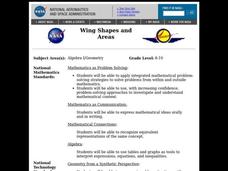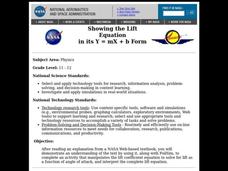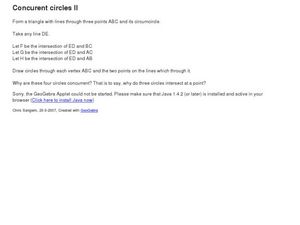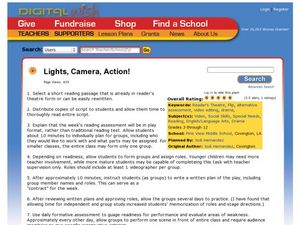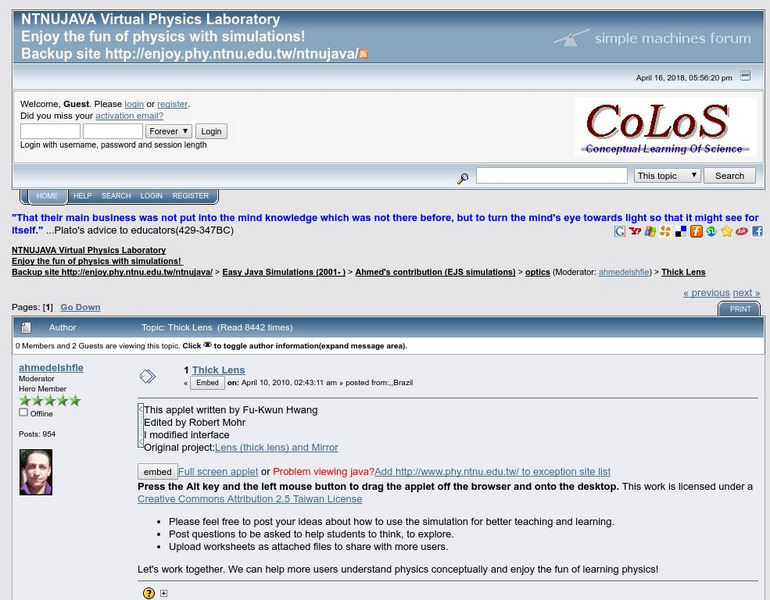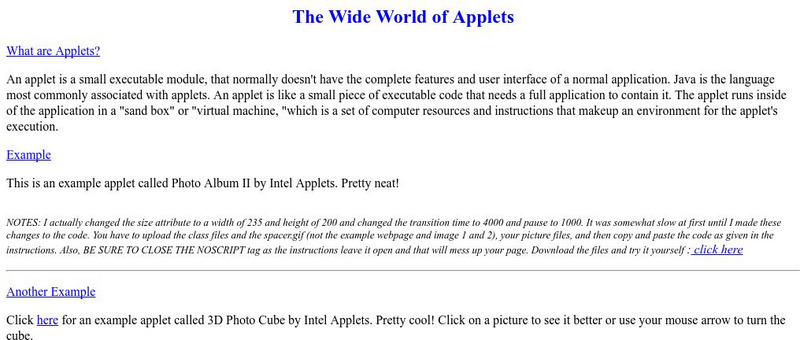Curated OER
Wing Shapes and Areas
Students, after reading the explanation given below, use FoilSim to determine the weight of the aircraft that can be lifted by a pair of wings of each type. They also design a unique platform of a wing to lift a plane weighing 11500 pounds.
Curated OER
Using Graphs to Compare
Students use the FoilSim computer simulation program, and demonstrate an understanding of the lift variables by explaining their graphical representations. They demonstrate an understanding of forces and motion.
Curated OER
Design of Airfoils and Problem- Solving Using FoilSim
Ninth graders, after reading the explanation given below, complete the problem-solving activities to demonstrate an understanding of the concepts presented.
Curated OER
Characteristics of Lift and Wing Area
Students use FoilSim to complete the activity and investigate the factors that affect lift and how wing area and lift are related.
Curated OER
Temperature and Altitude
Students, after reading the explanation given below, use FoilSim to gather and record data on temperature and altitude generated by the FoilSim control panel.
Curated OER
Showing the Lift Equation
Learners read an explanation from a NASA Web-based textbook, then demonstrate an understanding of the text by using it, along with FoilSim, to complete an activity that manipulates the lift coefficient equation.
Curated OER
Using 3-D Models for Code Validation with FoilSim
Students use FoilSim to complete the activity to create tables of data sets comparing the lift values for a 3-D model of a symmetrical wing section to the values predicted by the FoilSim software.
Curated OER
Wing Specifications
Ninth graders use FoilSim to fulfill the specifications of a given airfoil (wing) and plot and interpret graphs.
Curated OER
Lift Equation Problem Set
Pupils, after reading an explanation from a NASA Web-based textbook, demonstrate an understanding of the text by using it, along with FoilSim, to complete an activity to graph and interpret the lift equation.
Curated OER
Wing Area Effects Problem Set
High schoolers read an explanation from a NASA Web-based textbook on lift and an explanation on the FoilSim software package given below. They use FoilSim to evaluate the relationship between wing area and lift.
Curated OER
Velocity Effects Problem Set
Students, after reading an explanation on lift from a NASA Web-based textbook and an explanation on the FoilSim software package given below, use FoilSim to evaluate the relationship between velocity and lift.
Curated OER
Sunspots: Correlating Sunspots to Active Regions
Students investigate sunspots. They use solar imaging from satellite instruments which are currently circling the sun. Students compare images from the satellites and determine the existence of a correlation between the two types of...
Curated OER
Wind Surge: Interactive On-line Mac and PC
Students examine the influence of the end wall. They find a basin size and wind speed such that a given wall height is overtopped. Then, increase the wall elevation until overtopping stops. Students explain the difference in results.
Curated OER
Concurent Circles II
In this geometry worksheet, students draw a shape based on the directions. They tell the reasons the four resulting circles are concurrent. A sample drawing is included.
Curated OER
Gas Law Program
In this chemistry learning exercise, students complete an online calculation focused upon the Law of Gases. The sheet requires the right kind of internet browser.
Curated OER
Lights, Camera, Action!
Young scholars add various types of multimedia to a website they have created about volcanoes. They review what would best enhance their website and determine what the value and cost be in adding that particular piece of multimedia.
Curated OER
Volcanoes Crossword Puzzle
In this Volcanoes Crossword Puzzle worksheet, students solve a crossword puzzle by answering 13 questions related to volcanoes. An example question includes, "the outer layer of the earth."
Other
Ntnu Virtual Physics Lab: Thick Lens Java Applet
An interactive Java applet which allows the user to investigate the path of light through a lens shape object. The shape of the object, the index of refraction of the material, and the location of the incident rays can be altered.
Other
Tonya Skinner: The Wide World of Applets
This page give a nice definition of Java applets and two examples of an applet. Download the files and try it yourself!
Other
Java Applets for Coastal Engineer
If you have a browser that supports Java, you may find this site interesting. A series of Applets allow you to investigate wave generation and behavior.
Other
Hot Scripts: Java
This resource presents an internet directory of resources for Java programmers.
Rice University
Teach Java 2005
A collection of documents and software resources for the Java program developer.
University of Colorado
University of Colorado: Physics 2000: Quantum Atom
Several pages with an interesting discussion of the visible light spectrum and atomic absorption and emission line spectrum. Features excellent graphics, thorough and understandable discussion, and many interactive Java applets.


